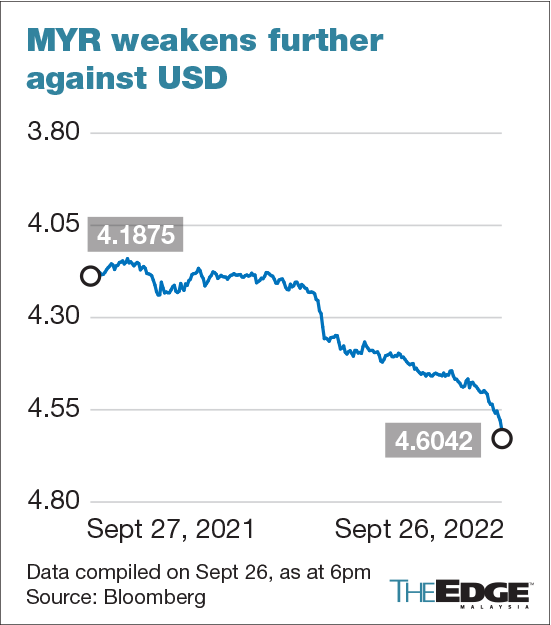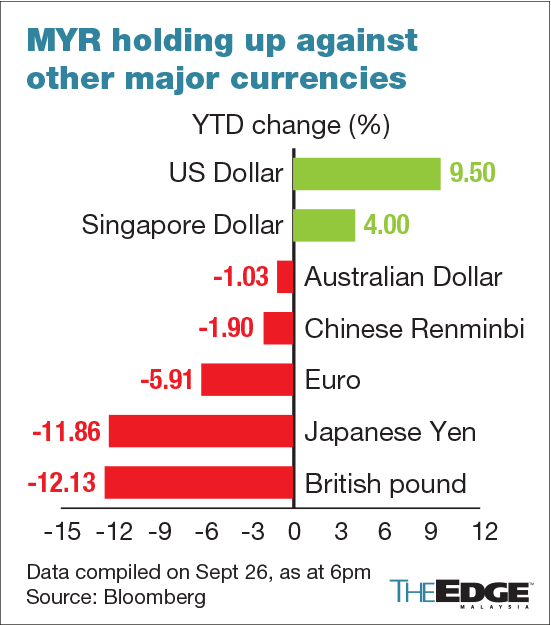
KUALA LUMPUR (Sept 27): Malaysia will have to brace itself for further downward pressure on the ringgit, at least until the US Federal Reserve (Fed) ends its monetary tightening cycle, which is expected in the first half of 2023, say economists.
“The ringgit, along with other regional currencies, has been subject to the strong US dollar, backed by the Fed’s aggressive monetary policy moves to fight inflation, even [if] it means inflicting a recession on the US economy,” Socio-Economic Research Centre (SERC) executive director Lee Heng Guie told The Edge on Monday (Sept 26).
“The ringgit, operating under a flexible exchange rate regime, will have to absorb the volatility of capital flows and investors’ preference towards higher-yielding assets, as in this case the US dollar assets. Simply put, the reason investors look to buy currencies with higher interest rates is that it creates an additional rate of return on their currency exchange,” he said.
UOB Malaysia senior economist Julia Goh concurred. “Our view is that as long as [the] US stays the course for outsized rate hikes and China’s worries persist, we think that most Asian currencies including the ringgit will be on the defensive against the US dollar,” she told The Edge.
Last week, the Fed raised its interest rates by 75 basis points (bps) for the third consecutive time to a range of 3% to 3.25% — the highest level since 2008 — to tackle record inflation. The US central bank has so far raised rates a total of 300 bps, or 3%, since March, while the US Federal Open Market Committee had reportedly said it “anticipates that ongoing increases in the target range will be appropriate”.
However, the US’ interest-rate increases have caused shocks in financial markets and economies around the world. The ringgit sank to a new 24-year low against the US dollar on Monday to close at 4.6038 — its lowest level since Sept 1, 1998, when it was traded at 4.7125 against the greenback. The ringgit had fallen 9.5% year to date.
However, the local currency traded higher compared with other major regional currencies on Monday. The ringgit strengthened against the Singapore dollar to 3.2092, from last Friday (Sept 23)’s 3.2138.
The ringgit also appreciated against the euro at 4.4401 from 4.4701, and performed better against the British pound at 4.9481, from 5.1149.
Dr Yeah Kim Leng, professor of economics at Sunway University Business School, said some countries may face currency or debt distress, as reflected in increased borrowing from the International Monetary Fund (IMF). But a large-scale meltdown such as the Asian Financial Crisis remains unlikely because most Asian economies have accumulated substantial international reserves since the crisis happened from 1997 to 1998, he added.
He also expects the ringgit to likely continue its downward trend against the US dollar till early next year, because of the Fed’s “higher-for-longer” stance to tame inflation and when a positive real interest rate is achieved.
Malaysia’s moderate inflation increase has led to three consecutive 25-bps hikes to 2.5%, bringing the year-to-date increase to 75 bps.
“The narrowing interest rate differential is one of the factors contributing to the ringgit breaching the psychological level of 4.50 against the [US] dollar,” said Yeah.
‘Re-pegging the ringgit not the best solution’
SERC’s Lee is of the view that the government should not resort to capital controls or the ringgit re-pegging to stem its decline, as this could prove futile and counterproductive and have adverse effects on the ringgit, as well as domestic equity and bond markets.
“Capital controls and re-pegging of the ringgit would [also] result in more capital outflows and accentual further sliding of the ringgit.
“We have to continue enhancing our economic and financial resilience, including implementing painful reforms to strengthen our fundamental support for and confidence in the ringgit,” he said.
Lee noted that Malaysia has to sustain the inflows of dependable long-term investment in the country, continued accumulation of trade surplus and build a war chest of foreign exchange to strengthen the defence line for the ringgit.
Sunway University’s Yeah said while the re-pegging of the ringgit may provide a temporary respite to the slide against the US dollar, the cost and unintended long term consequences will likely be huge.
Since the ringgit fall against the greenback is a double-edged sword, a boon to exporters but a bane to importers and debtors, the appropriate policy response is to ease the pain, which is likely to be temporary until the US economy and inflation conditions reverse course, he said.
“Temporary relief to forestall any systemic financial distress can be achieved through the provision of standby facilities and financial assistance for affected corporates and individuals to ride through dollar crunch,” Yeah added.
Last Friday, Bank Negara Malaysia (BNM) Governor Tan Sri Nor Shamsiah Mohd Yunos said the central bank’s policy priority now is to sustain economic growth in an environment of price stability and to further strengthen domestic economic fundamentals through structural reforms, rather than resorting to capital controls or re-pegging of the ringgit. This, she added, will provide a more enduring support for the ringgit.
To receive CEO Morning Brief please click here.
- China's DeepSeek says theoretical profit margin is 545% for its AI models
- MyDigital ID can now be used to access Sumbangan Tunai Rahmah portal, says IRB
- Norway PM plans to raise financial support for Ukraine
- No provision in Act 522 against 50-year-old practice of mixing imported and local white rice — ministry
- EPF’s strong performance reflects investor confidence in govt's growth-friendly policies — PM
- China's DeepSeek says theoretical profit margin is 545% for its AI models
- Norway PM plans to raise financial support for Ukraine
- No provision in Act 522 against 50-year-old practice of mixing imported and local white rice — ministry
- EPF’s strong performance reflects investor confidence in govt's growth-friendly policies — PM
- MyDigital ID can now be used to access Sumbangan Tunai Rahmah portal, says IRB



